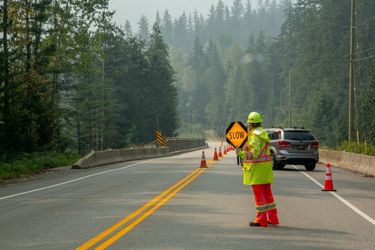
Written by Kayla Jane Barrie Updated on Feb 26, 2025 5 mins read

Construction seems to find its way to every route you drive, doesn't it? But did you know road rules change and corresponding fines for failure to follow these rules are more severe? Ignoring the rules of construction zones could leave you hefty fines and increase your car insurance quotes. Here's how you can drive safely through construction zones and which signs to pay attention to keep you, other drivers, and workers safe.
Not all construction zones have the same speed limit. That's why it's important to pay attention to signs leading up to the area. Generally, construction zone speed limits will be between 50 km/h to 70km/h on highways. They will be considerably less on secondary or regional roads.
Construction zones can be defined as areas marked with traffic control devices such as signage or pylons. These markings will be seen at the beginning and end of the zone. There may be a flag person or traffic control person to help direct the flow of traffic.
Be prepared to stop and slow down when you are driving towards a construction zone.

According to the MTO, roads need substantial repair every 15-25 years. As a driver in Ontario, it sure feels like it happens much more often than that, doesn't it?
It always helps to be prepared before you get into your car and start driving. Here are some tips to help you when driving through a construction zone.
Did you know that if you are caught speeding in a construction zone, the fines are doubled? You can be fined up to $500 in Ontario and three demerit points (or more) for not obeying the traffic control person or posted signage.
Have you ever been driving and noticed a construction zone, but there are no workers present? Do you need to slow down if there is no work being done?
Legally, yes, you should slow down in a construction zone even if workers are not present. If you are caught, you can still face fines.
Slower speeds are not only in effect to protect workers but also to protect drivers. The speed limits are determined by the type of work being done and factor in any changes in road characteristics.
For example, speed reductions in construction zones can protect drivers from hazards including :
| Construction work is a specific number of kilometres ahead. |
 |
There is road work ahead. |
 |
There is a survey crew working on the road ahead. |
 |
Traffic control person ahead - drive slowly and watch for specific instructions. |
 |
You are entering a construction zone. Drive with extra caution and be prepared for a lower speed limit. |
 |
Temporary detour from the regular traffic route. |
 |
Flashing lights on the arrows show the direction that you should follow. |
 |
The pavement has been milled or grooved. Your vehicle's stopping ability may be affected poorly - obey the speed limit and drive with extra caution. |
 |
Lane ahead is closed for roadwork and will end. Obey the speed limit and merge with traffic in the open lane. |
 |
The lane is closed. Adjust speed to merge with traffic in the lane indicated by the arrow. |
 |
| Do not pass the pilot vehicle or pace vehicle when you see this sign. |
 |
Reduce speed or be prepared to stop. |
 |
Follow the detour marker until you return to the regular route. |
 |
Enforces doubling fines for speeding in a designated construction zone when there are workers present. |
 |
You should not pass other vehicles in a construction zone due to the unpredictable conditions of the road ahead. There may be pavement work or a lane that ends. Be patient, and wait until you are out of the construction zone to pass another vehicle.
It's important to know that the fines will be doubled if you are caught speeding in a construction zone. If you are caught driving over 30km/h in a construction zone, you may face fines for driving 60 km/h – which would be classified as stunt driving, and your license could be suspended.
In addition to reduced speed, any violation in a construction zone is subject to double fines.
Driving through a construction zone can be dangerous because of debris, loose gravel, lane changes, and no shoulders.
| Categories | Auto |
|---|---|
| Tags | Driving Tips |
Read our insurance blog to get helpful tips, information and news.
Has your car been totalled in an accident? Is your car a write off? Learn about vehicle write offs for a total loss insurance claim.
Get the facts on Toronto's auto theft problem. We break down the data, reveal the most-stolen vehicles (including the Honda CR-V and Lexus RX 350), and show which neighbourhoods are most affected.
Dive into the world of auto theft with our blog on the most stolen cars in Canada. See the most stolen cars across Canada, including provincial lists for Ontario and Quebec, and learn how high-risk models can affect your car insurance premiums.
Drive safe this winter! Check out these tips for driving in snowy and icy conditions in Ontario. Get other helpful info and FAQs on winter driving.